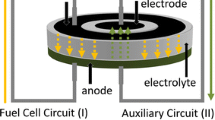Abstract
The carbon amounts of simulated syngases with different compositions were calculated in this study. The degradation and carbon deposition behavior of solid oxide fuel cells (SOFCs) with an active area of 4 cm × 4 cm were then investigated under the simulated syngases at work conditions. Carbon deposition occurred over time with a little or no H2O and CO2 in these gasses, which significantly degraded the single cells. The cell stabilized within 1 h under a gas mixture of 70 % H2–30 % CO because of the chocking of inlet pipelines of the testing house by carbon deposition. Addition of proper H2O and CO2 in the simulated syngas effectively suppressed carbon deposition in the pipelines. However, carbon was still deposited gradually in the single cell anode when H2O and CO2 were insufficient. The mechanisms of carbon deposition were different when the cells were exposed under different syngases. Single cells steadily thrived under 50 % H2–20 % CO–10 % CO2–20 % H2O and 50 % H2–20 % CO–20 % CO2–10 % H2O gas mixtures for about 2000 h without carbon deposition.










Similar content being viewed by others
References
Sumi H, Lee YH, Muroyama H, Matsui T, Kamijo M, Mimuro S, Yamanaka M, Nakajima Y, Eguchi K (2011) Effect of carbon deposition by carbon monoxide disproportionation on electrochemical characteristics at low temperature operation for solid oxide fuel cells. J Power Sources 196:4451–4457
Weber A, Sauer B, Muller AC, Herbstritt D, Ivers-Tiffee E (2002) Oxidation of H2, CO and methane in SOFCs with Ni/YSZ-cermet anodes. Solid State Ionics 152–153:543–550
Alzate-Restrepo V, Hill JM (2010) Carbon deposition on Ni/YSZ anodes exposed to CO/H2 feeds. J Power Sources 195:1344–1351
Miao H, Wang WG, Li TS, Chen T, Sun SS, Xu C (2010) Effects of coal syngas major compositions on Ni/YSZ anode-supported solid oxide fuel cells. J Power Sources 195:2230–2235
Chen T, Wang WG, Miao H, Li TS, Xu C (2011) Evaluation of carbon deposition behavior on the nickel/yttrium-stabilized zirconia anode-supported fuel cell fueled with simulated syngas. J Power Sources 196:2461–2468
Kim T, Liu G, Boaro M, Lee SI, Vohs JM, Gorte RJ, Al-Madhi OH, Dabbousi BO (2006) A study of carbon formation and prevention in hydrocarbon-fueled SOFC. J Power Sources 155:231–238
Li C, Shi Y, Cai N (2013) Carbon deposition on nickel cermet anodes of solid oxide fuel cells operating on carbon monoxide fuel. J Power Sources 225:1–8
Ye XF, Wang SR, Zhou J, Zeng FR, Nie HW, Wen TL (2010) Assessment of the performance of Ni-yttria-stabilized zirconia anodes in anode-supported solid oxide fuel cells operating on H2-CO syngas fuels. J Power Sources 195:7264–7267
Takeguchi T, Kani Y, Yano T, Kikuchi R, Eguchi K, Tsujimoto K, Uchida Y, Ueno A, Omoshiki K, Aizawa M (2002) Study on steam reforming of CH4 and C2 hydrocarbons and carbon deposition on Ni-YSZ cermets. J Power Sources 112:588–595
Finnerty CM, Coe NJ, Cunningham RH, Ormerod RM (1998) Carbon formation on and deactivation of nickel-based/zirconia anodes in solid oxide fuel cells running on methane. Catal Today 46:137–145
Kim H, Lu C, Worrell WL, Vohs JM, Gorte RJ (2002) Cu-Ni cermet anodes for direct oxidation of methane in solid-oxide fuel cells. J Electrochem Soc 149:A247–A250
Martnez-Arias A, Hungra AB, Fernandez-Garcia M, Iglesias-Juez A, Conesa JC, Mather GC, Munuera G (2005) Cerium-terbium mixed oxides as potential materials for anodes in solid oxide fuel cells. J Power Sources 151:43–51
Tao S, Irvine JTS (2003) A redox-stable efficient anode for solid-oxide fuel cells. Nat Mater 2:320–323
Huang YH, Dass RI, Xing ZL, Goodenough JB (2006) Double perovskites as anode materials for solid oxide fuel cells. Science 312:254–257
Burnette DD, Kremer GG, Bayless DJ (2008) The use of hydrogen-depleted coal syngas in solid oxide fuel cells. J Power Sources 182:329–333
Sasaki K, Teraoka Y (2003) Equilibria in fuel cell gases. I. Equilibrium compositions and reforming conditions. J Electrochem Soc 150:A878–A884
Sasaki K, Teraoka Y (2003) Equilibria in fuel cell gases. II. The C-H-O ternary diagrams. J Electrochem Soc 150:A885–A888
Haanappel VAC, Mai A, Mertens J (2006) Electrode activation of anode-supported SOFCs with LSM- or LSCF-type cathodes. Solid State Ionics 177:2033–2037
Tuinstra F, Koenig JL (1969) Raman spectrum of graphite. J Chem Phys 53:1126–1130
Li C, Shi Y, Cai N (2011) Mechanism for carbon direct electrochemical reactions in a solid oxide electrolyte direct carbon fuel cell. J Power Sources 196:754–763
Grabke HJ (2003) Metal dusting. Mater Corros 54:736–746
Zhang J, Schneider A, Inden G (2008) Initiation and growth of iron metal dusting in CO-H2-H2O gas mixtures. Corros Sci 50:1020–1034
Li TS, Wang WG, Miao H, Chen T, Xu C (2010) Effect of reduction temperature on the electrochemical properties of a Ni/YSZ anode-supported solid oxide fuel cell. J Alloys Compd 495:138–143
Acknowledgments
The authors are grateful for the financial supports from the National Natural Science Foundation of China (Grant No. 21103212).
Author information
Authors and Affiliations
Corresponding authors
Rights and permissions
About this article
Cite this article
Miao, H., Liu, G., Chen, T. et al. Behavior of anode-supported SOFCs under simulated syngases. J Solid State Electrochem 19, 639–646 (2015). https://doi.org/10.1007/s10008-014-2640-7
Received:
Revised:
Accepted:
Published:
Issue Date:
DOI: https://doi.org/10.1007/s10008-014-2640-7




